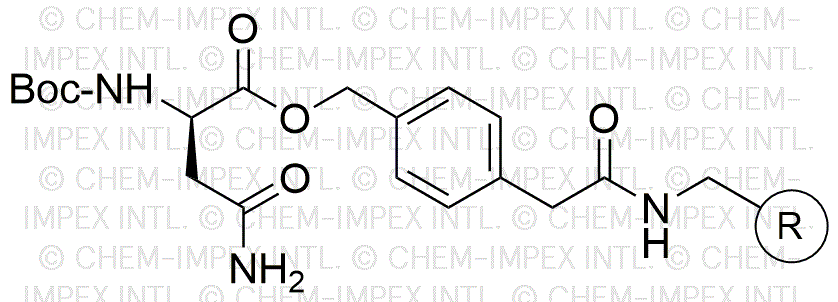Na-Boc-D-asparagine 4-oxymethylphenylacetamidomethyl is widely utilized in research focused on:
- Peptide Synthesis: This compound serves as a valuable building block in the synthesis of peptides, particularly in the development of therapeutic agents and biologically active molecules.
- Drug Development: Its unique structure allows for modifications that can enhance the efficacy and selectivity of drug candidates, making it essential in pharmaceutical research.
- Bioconjugation: The compound is used in bioconjugation processes to attach biomolecules to drugs or imaging agents, improving targeting and reducing side effects.
- Protein Engineering: Researchers utilize it to modify proteins, enhancing their stability and activity, which is crucial in developing enzyme-based therapies.
- Analytical Chemistry: It aids in the development of analytical methods for detecting and quantifying amino acids and peptides, supporting quality control in various industries.
General Information
Properties
Safety and Regulations
Applications
Na-Boc-D-asparagine 4-oxymethylphenylacetamidomethyl is widely utilized in research focused on:
- Peptide Synthesis: This compound serves as a valuable building block in the synthesis of peptides, particularly in the development of therapeutic agents and biologically active molecules.
- Drug Development: Its unique structure allows for modifications that can enhance the efficacy and selectivity of drug candidates, making it essential in pharmaceutical research.
- Bioconjugation: The compound is used in bioconjugation processes to attach biomolecules to drugs or imaging agents, improving targeting and reducing side effects.
- Protein Engineering: Researchers utilize it to modify proteins, enhancing their stability and activity, which is crucial in developing enzyme-based therapies.
- Analytical Chemistry: It aids in the development of analytical methods for detecting and quantifying amino acids and peptides, supporting quality control in various industries.
Documents
Safety Data Sheets (SDS)
The SDS provides comprehensive safety information on handling, storage, and disposal of the product.
Product Specification (PS)
The PS provides a comprehensive breakdown of the product’s properties, including chemical composition, physical state, purity, and storage requirements. It also details acceptable quality ranges and the product's intended applications.
Certificates of Analysis (COA)
Search for Certificates of Analysis (COA) by entering the products Lot Number. Lot and Batch Numbers can be found on a product’s label following the words ‘Lot’ or ‘Batch’.
Número de catálogo
Número de lote/lote
Certificates Of Origin (COO)
This COO confirms the country where the product was manufactured, and also details the materials and components used in it and whether it is derived from natural, synthetic, or other specific sources. This certificate may be required for customs, trade, and regulatory compliance.
Número de catálogo
Número de lote/lote
Safety Data Sheets (SDS)
The SDS provides comprehensive safety information on handling, storage, and disposal of the product.
DownloadProduct Specification (PS)
The PS provides a comprehensive breakdown of the product’s properties, including chemical composition, physical state, purity, and storage requirements. It also details acceptable quality ranges and the product's intended applications.
DownloadCertificates of Analysis (COA)
Search for Certificates of Analysis (COA) by entering the products Lot Number. Lot and Batch Numbers can be found on a product’s label following the words ‘Lot’ or ‘Batch’.
Número de catálogo
Número de lote/lote
Certificates Of Origin (COO)
This COO confirms the country where the product was manufactured, and also details the materials and components used in it and whether it is derived from natural, synthetic, or other specific sources. This certificate may be required for customs, trade, and regulatory compliance.

